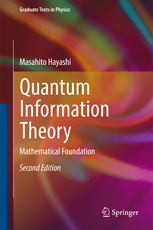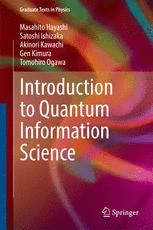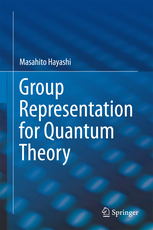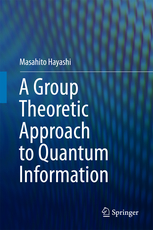
| Hayashi's Books |
Quantum Information Theory: Mathematical Foundation(Second edition of Quantum Information: An Introduction)
Graduate Texts in Physics, Springer-Verlag 2017
ISBN 978-3-662-43501-4

| Masahito Hayashi |
This graduate textbook provides a unified view of quantum information theory. Clearly explaining the necessary mathematical basis, it merges key topics from both information-theoretic and quantum- mechanical viewpoints and provides lucid explanations of the basic results. Thanks to this unified approach, it makes accessible such advanced topics in quantum communication as quantum teleportation, superdense coding, quantum state transmission (quantum error-correction) and quantum encryption. Since the publication of the preceding book Quantum Information: An Introduction, there have been tremendous strides in the field of quantum information. In particular, the following topics -- all of which are addressed here -- made seen major advances: quantum state discrimination, quantum channel capacity, bipartite and multipartite entanglement, security analysis on quantum communication, reverse Shannon theorem and uncertainty relation. With regard to the analysis of quantum security, the present book employs an improved method for the evaluation of leaked information and identifies a remarkable relation between quantum security and quantum coherence. Taken together, these two improvements allow a better analysis of quantum state transmission. In addition, various types of the newly discovered uncertainty relation are explained. Presenting a wealth of new developments, the book introduces readers to the latest advances and challenges in quantum information. To aid in understanding, each chapter is accompanied by a set of exercises and solutions.
Introduction to Quantum Information Science
Graduate Texts in Physics, Springer-Verlag 2017
ISBN 3-540-30265-4

| Masahito Hayashi, Satoshi Ishizaka, Akinori Kawachi, Gen Kimura, Tomohiro Ogawa
|
This book presents the basics of quantum information, e.g., foundation of quantum theory, quantum algorithms, quantum entanglement, quantum entropies, quantum coding, quantum error correction and quantum cryptography. The required knowledge is only elementary calculus and linear algebra. This way the book can be understood by undergraduate students. In order to study quantum information, one usually has to study the foundation of quantum theory. This book describes it from more an operational viewpoint which is suitable for quantum information while traditional textbooks of quantum theory lack this viewpoint. The current book bases on Shor's algorithm, Grover's algorithm, Deutsch-Jozsa's algorithm as basic algorithms. To treat several topics in quantum information, this book covers several kinds of information quantities in quantum systems including von Neumann entropy. The limits of several kinds of quantum information processing are given. As important quantum protocols,this book contains quantum teleportation, quantum dense coding, quantum data compression. In particular conversion theory of entanglement via local operation and classical communication are treated too. This theory provides the quantification of entanglement, which coincides with von Neumann entropy. The next part treats the quantum hypothesis testing. The decision problem of two candidates of the unknown state are given. The asymptotic performance of this problem is characterized by information quantities. Using this result, the optimal performance of classical information transmission via noisy quantum channel is derived. Quantum information transmission via noisy quantum channel by quantum error correction are discussed too. Based on this topic, the secure quantum communication is explained. In particular, the quantification of quantum security which has not been treated in existing book is explained. This book treats quantum cryptography from a more practical viewpoint.
Group Representation for Quantum Theory
Springer-Verlag 2017
ISBN 978-3-319-44904-3

| Masahito Hayashi |
This book explains the group representation theory for quantum theory in the language of quantum theory. As is well known, group representation theory is very strong tool for quantum theory, in particular, angular momentum, hydrogen-type Hamiltonian, spin-orbit interaction, quark model, quantum optics, and quantum information processing including quantum error correction. To describe a big picture of application of representation theory to quantum theory, the book needs to contain the following six topics, permutation group, SU(2) and SU(d), Heisenberg representation, squeezing operation, Discrete Heisenberg representation, and the relation with Fourier transform from a unified viewpoint by including projective representation. Unfortunately, although there are so many good mathematical books for a part of six topics, no book contains all of these topics because they are too segmentalized. Further, some of them are written in an abstract way in mathematical style and, often, the materials are too segmented. At least, the notation is not familiar to people working with quantum theory. Others are good elementary books, but do not deal with topics related to quantum theory. In particular, such elementary books do not cover projective representation, which is more important in quantum theory. On the other hand, there are several books for physicists. However, these books are too simple and lack the detailed discussion. Hence, they are not useful for advanced study even in physics. To resolve this issue, this book starts with the basic mathematics for quantum theory. Then, it introduces the basics of group representation and discusses the case of the finite groups, the symmetric group, e.g. Next, this book discusses Lie group and Lie algebra. This part starts with the basics knowledge, and proceeds to the special groups, e.g., SU(2), SU(1,1), and SU(d). After the special groups, it explains concrete applications to physical systems, e.g., angular momentum, hydrogen-type Hamiltonian, spin-orbit interaction, and quark model. Then, it proceeds to the general theory for Lie group and Lie algebra. Using this knowledge, this book explains the Bosonic system, which has the symmetries of Heisenberg group and the squeezing symmetry by SL(2,R) and Sp(2n,R). Finally, as the discrete version, this book treats the discrete Heisenberg representation which is related to quantum error correction. To enhance readers' undersnding, this book contains 54 figures, 23 tables, and 111 exercises with solutions.
A Group Theoretic Approach to Quantum Information
Springer-Verlag 2017
ISBN 978-3-319-45239-5

| Masahito Hayashi |
This book is the first one addressing quantum information from the viewpoint of group symmetry. Quantum systems have a group symmetrical structure. This structure enables to handle systematically quantum information processing. However, there is no other textbook focusing on group symmetry for quantum information although there exist many textbooks for group representation. After the mathematical preparation of quantum information, this book discusses quantum entanglement and its quantification by using group symmetry. Group symmetry drastically simplifies the calculation of several entanglement measures although their calculations are usually very difficult to handle. This book treats optimal information processes including quantum state estimation, quantum state cloning, estimation of group action and quantum channel etc. Usually it is very difficult to derive the optimal quantum information processes without asymptotic setting of these topics. However, group symmetry allows to derive these optimal solutions without assuming the asymptotic setting. Next, this book addresses the quantum error correcting code with the symmetric structure of Weyl-Heisenberg groups. This structure leads to understand the quantum error correcting code systematically. Finally, this book focuses on the quantum universal information protocols by using the group SU(d). This topic can be regarded as a quantum version of the Csiszar-Korner's universal coding theory with the type method. The required mathematical knowledge about group representation is summarized in the companion book, Group Representation for Quantum Theory.
ASYMPTOTIC THEORY OF QUANTUM STATISTICAL INFERENCE: Selected Papers
World Scientific Publishing 2005
ISBN 981-256-015-7

| edited by
Masahito Hayashi
Table of Contents |
Quantum statistical inference, a research field with deep roots in the foundations of both quantum physics and mathematical statistics, has made remarkable progress since 1990. In particular, its asymptotic theory has been developed during this period. However, there has hitherto been no book covering this remarkable progress after 1990; the famous textbooks by Holevo and Helstrom deal only with research results in the earlier stage (1960s-1970s). This book presents the important and recent results of quantum statistical inference. It focuses on the asymptotic theory, which is one of the central issues of mathematical statistics and had not been investigated in quantum statistical inference until the early 1980s. It contains outstanding papers after Holevo's textbook, some of which are of great importance but are not available now.
The reader is expected to have only elementary mathematical knowledge, and therefore much of the content will be accessible to graduate students as well as research workers in related fields. Introductions to quantum statistical inference have been specially written for the book. Asymptotic Theory of Quantum Statistical Inference: Selected Papers will give the reader a new insight into physics and statistical inference.
| Editorial Board: | Ascheron, C.E. |
Quantum Computation and Information:
From Theory to Experiment
(Here is online version.)
Springer, 2006
ISSN 3-540-33132-8

|
Edited by Hiroshi Imai and Masahito Hayashi Table of Contents |
Recently, the field of quantum computation and information has been developing through a fusion of results from various research fields in theoretical and practical areas. This book consists of the reviews of selected topics charterized by great progress and cover the field from theoretical areas to experimental ones. It contains fundamental areas, quantum query complexity, quantum statistical inference, quantum cloning, quantum entanglement, additivity. It treats three types of quantum security system, quantum public key cryptography, quantum key distribution, and quantum steganography. A photonic system is highlighted for the realization of quantum information processing.